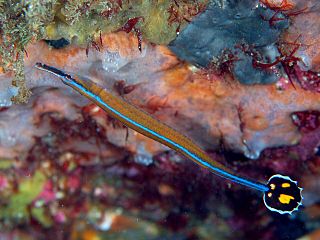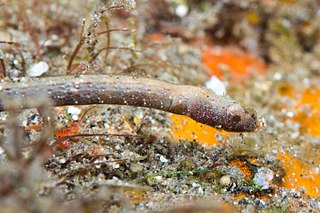
The Syngnathidae is a family of fish which includes seahorses, pipefishes, and seadragons. The name is derived from Greek, σύν (syn), meaning "together", and γνάθος (gnathos), meaning "jaw". This fused jaw trait is something the entire family has in common.
The longsnout pipefish is a pipefish of the family Syngnathidae. It has only been recorded from midwater and bottom trawls at depths of 37–212 metres (121–696 ft). The habitat and biology of this species are almost unknown but juveniles have been recorded in the stomachs of blue penguins and Snares penguins.

The greater pipefish is a pipefish of the family Syngnathidae. It is a seawater fish and the type species of the genus Syngnathus.

The estuarine pipefish or river pipefish is a species of fish in the family Syngnathidae. It is endemic to South Africa and has been sporadically recorded in the estuarine portions of the Kariega, Kasouga, Bushmans, East Kleinemonde and West Kleinemonde rivers. It can be readily distinguished from another southern African pipefish with which it shares its habitat, S. temminckii, by its much shorter snout. The estuarine pipefish is most commonly found in beds of the eelgrass Zostera capensis.

The messmate pipefish is a species of marine fish in the family Syngnathidae. It is widespread throughout the tropical waters of the Indo-Pacific region, from the eastern coast of Africa to the Vanuatu Islands. This species can reach a length of 19.8 cm. It occasionally makes its way into the aquarium trade where it is known as the dragonfaced pipefish. Other common names are bloodspot pipefish, reef pipefish, reeftop pipefish and yellow-streaked pipefish.
Doryrhamphus janssi, commonly known as the Janss' pipefish , is a species of pipefish belonging to the family Syngnathidae.

Corythoichthys intestinalis, known commonly as the scribbled pipefish, is a species of marine fish in the family Syngnathidae. Other common names used include banded pipefish, Australian banded pipefish, Australian messmate pipefish and messmate pipefish.

The worm pipefish is a species of pipefish, found in the North-eastern Atlantic along the coasts of Europe from the southern Norway, Kattegat and British Islands to Río de Oro in Western Sahara. The fish has a length of up to 15 cm. It inhabits rocky coastal areas with macrophytes at depths to 30 m.

The northern pipefish is a northwest Atlantic species of fish belonging to the family Syngnathidae.

Enneapterygius elegans, the hourglass triplefin, is a species of triplefin blenny in the genus Enneapterygius. It was originally described by Wilhelm Peters as a species of Tripterygium, in 1876, but was reassigned to Enneapterygius by W. Holleman in 1986. It is a tropical blenny known from reefs across the western central Indian to the central Pacific Ocean, and swims at a depth range of 0–12 metres. Male hourglass triplefins can reach a maximum length of 4 centimetres. The blenny gets its common name from an hourglass-shaped marking on its body.
Nannocampus is a genus of pipefishes native to the Indian and Pacific Oceans with these currently recognized species :
Penetopteryx is a genus of pipefishes.

Doryrhamphus japonicus, or the Honshu pipefish, is a species of flagtail pipefish from the genus Doryrhamphus that occurs in the Western Pacific Ocean, from Milne Bay, Papua New Guinea, to Sulawesi, Indonesia, the Philippines, and north as far as Honshu, Japan and Korea. It is a marine demersal pipefish that inhabits coastal lagoons, rocky and coral reefs, and tidal pools down to as deep as 30 metres (98 ft) but it is unusual below 10 metres (33 ft). This species is frequently found in association with sea urchins of the genus Diadema and with sponges. It is an active cleaner, feeding on parasites found on other fishes. It frequently shares crevices with shrimps, large mud crabs and occasionally moray eels.

Halicampus dunckeri or also commonly known as the Duncker's pipefish or ridgenose pipefish is a species of fish in the family Syngnathidae.

Corythoichthys flavofasciatus, known commonly as the network pipefish, reticulate pipefish and yellow-banded pipefish, is a species of marine fish in the family Syngnathidae.
Choeroichthys smithi is a species of marine fish of the family Syngnathidae. It is found in the western Indian Ocean along the coasts of Reunion, Mauritius, the Seychelles, Madagascar, Tanzania, Mozambique, and South Africa. It is a demersal species, inhabiting tide pools and reef flats in coastal waters where it can grow to lengths of 5 cm. This species is ovoviviparous, with males carrying the eggs and giving birth to live young. The specific name honours the South African ichthyologist J.L.B. Smith (1897-1968) who collected the material which was used as the holotype by Dawson when he described the species.

Cosmocampus banneri is a species of marine fish of the family Syngnathidae. It is found from the Red Sea and Western Indian Ocean to Fiji, the Marshall Islands, and the Ryukyu Islands. It lives in coral reefs at depths of 2-30m, where it can grow to lengths of 5.8 cm. Although little is known about the feeding habits of C. banneri, it is expected to feed on small crustaceans similar to other pipefish. This species is ovoviviparous, with males carrying eggs in a brood pouch until giving birth to live young. The specific name honours Albert Henry Banner (1914-1985), an American carcinologist who was an expert in alpheid shrimps.
Festucalex cinctus is a species of marine fish of the pipefish family Syngnathidae which is endemic to the waters off eastern Australia.
Nannocampus pictus, also known as the reef pipefish is a species of marine fish belonging to the family Syngnathidae. They can be found inhabiting reefs and seagrass beds of the western Indian Ocean and the eastern coast of Australia including the Great Barrier Reef. Members of this species can grow to lengths of 10 cm and their diet likely consists of small crustaceans such as copepods. Reproduction occurs through ovoviviparity in which the males brood eggs before giving live birth.
Nannocampus subosseus, also known as the bony-headed pipefish is a species of marine fish belonging to the family Syngnathidae. They can be found inhabiting reefs and tide pools only in the region of Shark Bay to Esperance, Western Australia. Members of this species can grow to lengths of 12 cm and their diet likely consists of small crustaceans such as copepods. Reproduction occurs through ovoviviparity in which the males brood eggs before giving live birth.












